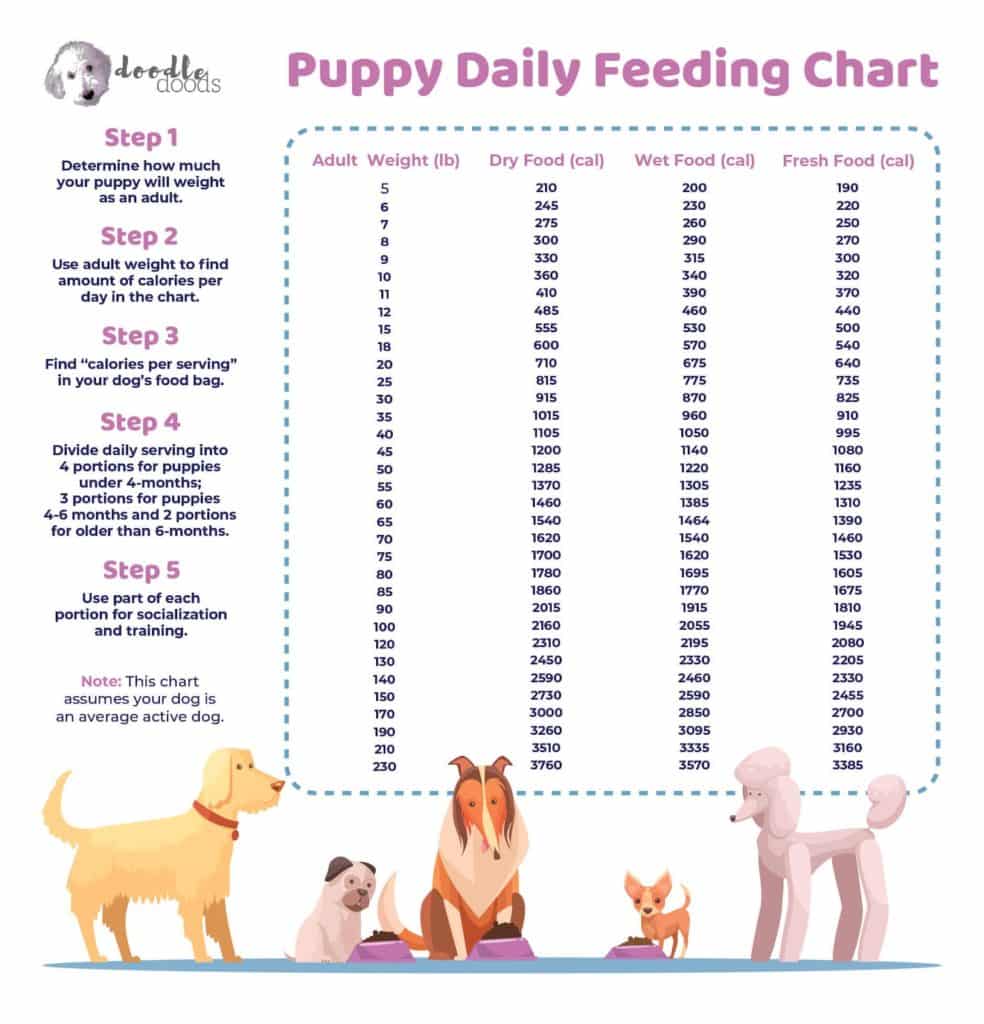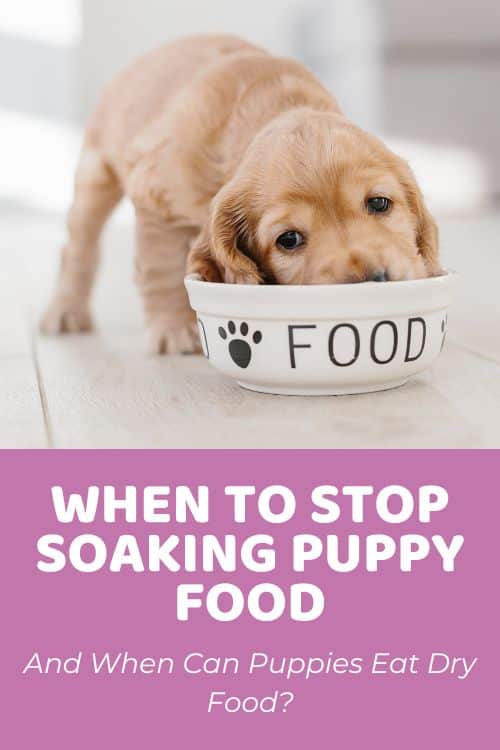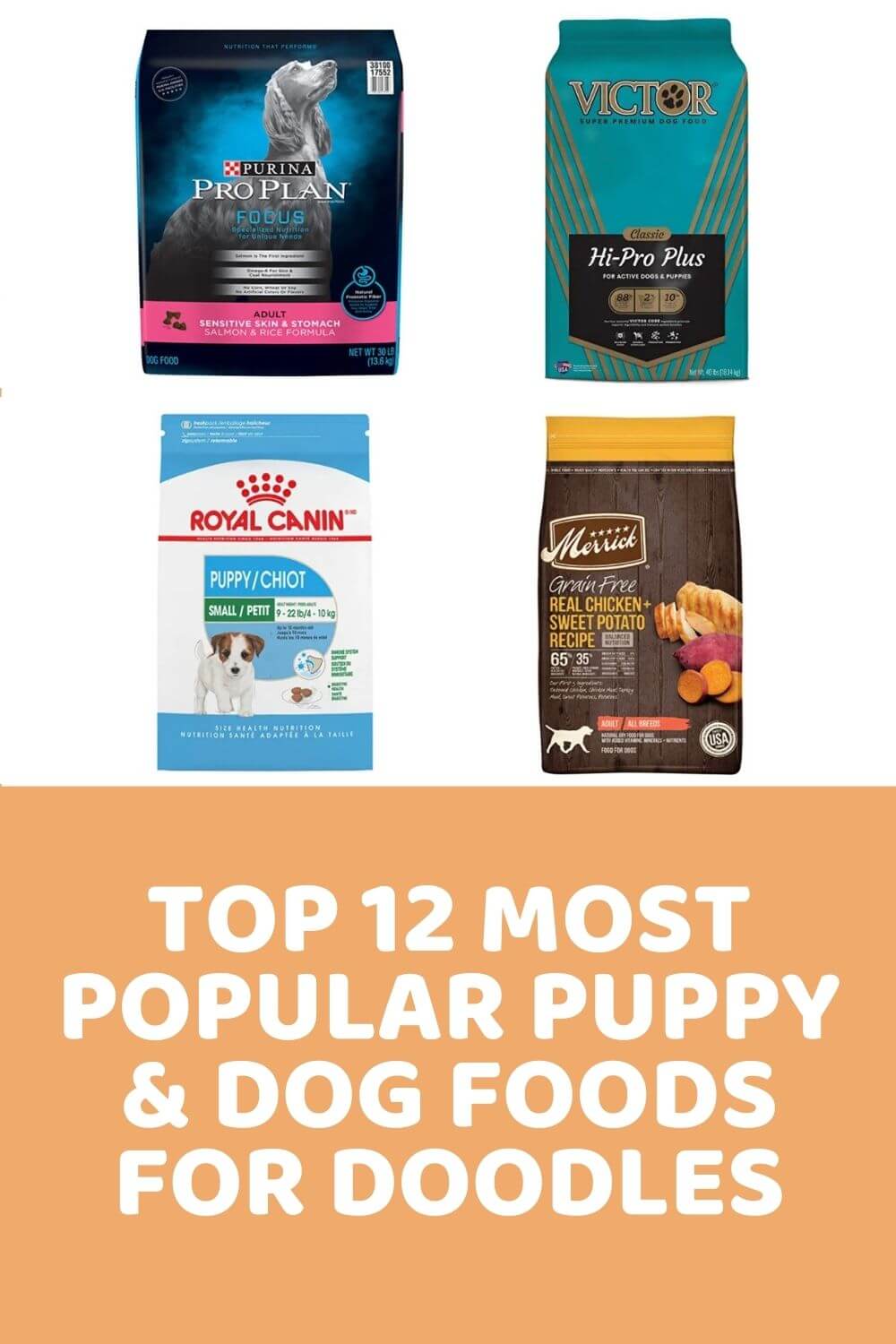If you’ve got your hands full with a puppy, or even a litter of puppies, you probably know all too well about their special requirements during this delicate life stage. During this time, puppies are also weaned from mother’s milk, at which point the question arises – when to stop soaking puppy food? And at what age can puppies eat dry food? In this article, we’re going to answer these very questions, and many others surrounding this topic.
If you know a little bit about dogs and puppies, you know how beneficial it is for newborn pups to feed on their mother’s milk. Mother’s milk is full of nutrients that keep the pups well-fed. It also provides vital antibodies that support the puppies’ immune systems. But what happens when it’s time for the puppies to start eating solid foods? You’ve probably heard that many people choose to soak dry kibble for this transitional period. So, what’s it all about? Let’s find out!
Table of Contents
- Why Do You Need To Soak Dry Food For Puppies?
- How Long Do You Soak Puppy Food?
- How Much Soaked Food Does Your Puppy Need?
- Does Soaking Puppy Food Make Digestion Easier?
- When to Stop Soaking Puppy Food? When Can Puppies Eat Dry Food?
- What Do I Feed My Puppy?
- How Can You Help Your Puppy Transition From Soaked Food To Dry Kibble?
- When To Stop Soaking Puppy Food: Frequently Asked Questions
- When To Stop Soaking Puppy Food: Final Thoughts
Why Do You Need To Soak Dry Food For Puppies?
Puppies do a lot of growing in their first year, especially in the very first weeks and months. Although feeding mother’s milk is the best way to go for the first weeks, puppies can’t keep suckling on their mama’s milk forever. It’s generally recommended to start the weaning process once the puppies start getting their baby teeth. This usually happens around the 3 to 4 week mark.
Now, even though the baby teeth could indicate that your new puppy should be able to switch to dry kibble, it might not be that simple.
First of all, baby teeth aren’t nearly as strong as adult teeth. Therefore, it’s probably not going to be particularly easy for a puppy with its new baby teeth to chew through each bite. Secondly, puppies simply aren’t used to chewing their food. After all, they’ve been sucking on milk for their whole life so far. That’s the only way they know how to eat!
And finally, keep in mind that any major dietary change is going to wreak havoc on a puppy’s digestive system if not done properly. If so far a puppy has gotten all of its food and nutrients from mother’s milk, immediately switching to dry kibble is bound to cause digestive issues.
For this reason, many dog breeders and puppy owners soak the dry kibble to make the transition from mother’s milk to solid food easier for the pups. Obviously, soaking the dry kibble will make it all soft and mushy, making it so much easier to consume. In addition to that, it’s much easier to entice a puppy to eat soaked kibble, as it usually has a much stronger and tastier smell than dry kibble on its own.
How Long Do You Soak Puppy Food?
Soaking puppy food is very simple and straightforward. Simply measure the correct amount of puppy kibble in a bowl (check the feeding instructions on the packaging!) and cover it with warm water. You’ll always want to use warm water to make it appealing and tasty for the pups. I bet that you wouldn’t touch cold and soggy porridge, either!
About the timing – usually 10 to 20 minutes should be perfectly enough to transform the dry kibble into a soft mush. Although it might be tempting to soak the kibble longer, we strongly advise against it.
Keep in mind that moisture is the perfect breeding ground for bacteria. So, if you leave the kibble soaking for hours on end, it might do more harm than good. Not to mention, flies and other insects will surely find their way to the soaked puppy food if you leave it out for too long.
Once you’ve soaked the kibble for 10 to 20 minutes, it’s almost ready for your puppy’s mealtime. However, we do recommend you give it a good stir before serving it to your pup. This will make it super mushy and soft, and give it a nice, smooth consistency.
Of course, you’ll also want to check the temperature of the food. Although it’s perfectly fine to use hot boiled water to soak the kibble, you should never feed your pup scorching hot food. Make sure that the food is warm enough, but not uncomfortably hot.
Moreover, since puppies are still learning good eating habits, you might want to serve their soaked kibble on a flat plate or surface. High rimmed bowls can prove to be quite an obstacle for small puppies, so make sure that the food is accessible for your little pal.
How Much Soaked Food Does Your Puppy Need?
We’ve mentioned a few times already how important it is to feed your puppy the right amount of food. Overfeeding can quickly lead to excessive weight gain, which in turn paves the way for a whole range of health issues. Similarly, underfeeding will leave your pup malnourished, and can cause a different set of health and developmental problems.
Regardless if you feed your puppy soaked food or dry kibble, it’s crucial that you measure out the correct amount of food each day. How much food your puppy needs is based on their age, size, and estimated adult weight.
The easiest way to do this is by checking the feeding instructions and calories on the back of your dry kibble packaging. Then, you can follow our puppy daily feeding chart to help determine the exact amount of dry kibble and calories that your pup needs daily:

Does Soaking Puppy Food Make Digestion Easier?
Yes and no. As we mentioned earlier, soaking dry kibble during the transitional period is super helpful for a variety of reasons, one of them being the digestive process. If a puppy has so far only consumed a liquid diet, immediately switching to dry kibble may cause some issues. On the other hand, it might not. It really is individual and what works for one pup might not work for another.
Now, if your puppy has been struggling with tummy issues for quite some time, it’s obviously not going to be fixed by soaking their dry kibble. In fact, many dog breeds are prone to stomach problems and food intolerances, so that’s something worth remembering.
If your puppy’s transition from mother’s milk to puppy food has been done over a longer period of time and your puppy also drinks enough water daily, but they’re still having digestive issues, it’s time for a vet visit.
When to Stop Soaking Puppy Food? When Can Puppies Eat Dry Food?
So, when to stop soaking puppy food? When can puppies eat dry food? As each puppy is unique and develops at their own pace, there’s no one-size-fits all approach to this. When to stop soaking puppy food varies from pup to pup, and even puppies from the same litter may adjust at a different pace.
Generally, we can expect puppies to be fully weaned by 6 weeks of age or slightly later. Usually by the 8 week mark, puppies should have all of their baby teeth, and they potentially could eat only dry food. Nonetheless, if your puppy is still struggling with dry food, it’s completely fine to feed them soaked kibble instead.
Based on this timeline, puppies can eat soaked food for up to 12 weeks of age. Usually around the 10 to 12 week mark puppies already show more interest in dry food, as they’ve learned how to use their teeth and eat regular food.
What Do I Feed My Puppy?
If you’ve adopted your new puppy from a breeder, we can safely assume that your new pup will come home sometime around 8 weeks of age. This will give the puppy plenty of time to be fully weaned and also adjust to eating dry kibble.
Of course, there are also instances when your puppy gets home sooner than that. Or maybe your adult mama dog has had a litter of its own that you now need to take care of. If you’ve got a puppy younger than 2 months old at home, it’s crucial you know what to feed your puppy during these early life stages to make sure they get to properly develop and grow into a healthy dog.
0-2 Weeks
From birth to 2 weeks of age, newborn puppies are in the neonatal period. For the first 2 weeks puppies are extremely fragile and delicate, they can’t see or hear, and they rely on their mama for everything, including food.
In fact, during this life stage, puppies spend 10% of their time suckling and 90% sleeping. So, you can only imagine how important it is for a puppy to get plenty of mama’s milk during this time.
Of course, mother’s milk is not always available. In these instances, you can replace mother’s milk with a good quality puppy milk replacer that will provide your newborn puppy the same balanced nutrient profile with antibodies.
3-4 Weeks
Now puppies enter the transitional period. They’re getting a bit stronger, they start opening their eyes, they start hearing better, and they develop a sense of smell. Puppies will also cut their first milk teeth, which is usually a great indicator that it’s time to start the weaning process.
Around the 3 to 4 week mark, puppies will slowly start weaning from mother’s milk (or puppy milk replacer), and get acquainted with puppy food. You’ll want to introduce only small portions of puppy food at a time to ensure that the transition is as smooth as possible. We also strongly recommend you soak the dry puppy food to make it more appealing, and easier to eat and digest.
6 Weeks
By 6 weeks of age, most puppies are fully weaned and ready to start eating real puppy food. On the other hand, it’s crucial that you don’t rush the weaning process, as it can create problems around food when your puppy is all grown up.
At 6 weeks old, your puppy can already eat according to scheduled mealtimes, around 5 to 6 meals per day. Depending on how the weaning process and puppy food transition has gone, it’s very likely that your pup won’t need any more soaked food. However, it’s completely normal if your pup prefers soft and mushy kibble at this stage, especially if they’re still recovering from the teething madness.
8-12 Weeks
Now that your puppy isn’t a newborn anymore, it’s time to make some changes in their diet. From 8 to 12 weeks old, puppies should eat around 3 to 4 times a day. Around the 8 to 12 week mark you can also start transitioning your puppy from soaked food to dry kibble.
If your new puppy comes home from a breeder, it’s highly likely that they’re already eating solid, dry foods at all times. Be sure to ask your breeder exactly the type of food your puppy has been eating so far, and continue to feed the exact same food at home. If you do decide to switch your puppy’s formula altogether, be sure to do this gradually over a longer period of time to avoid any digestive issues.
If your puppy’s transition from soaked food to dry kibble has taken a bit more time, your breeder will let you know about the process and share with you some tips on how to continue at home.
How Can You Help Your Puppy Transition From Soaked Food To Dry Kibble?
As with any dietary change, you want to make the transition as smooth and seamless as possible. First, the weaning process from mother’s milk to puppy food should be done over a period of time. Then, you’ll also want to make the transition from soaked food to dry kibble gradually. This way, your puppy’s digestive system has time to adjust.
The process for this is quite simple – once your puppy is fully weaned and only feeds on soaked kibble, you can start adding smaller amounts of water to the food each day. Before you know it, your puppy is inhaling all of its dry kibble with no problems.
Still, keep in mind that the process from soaked food to dry kibble will take time, even up to several weeks. The key here is to transition your puppy from soaked to dry food as gradually as possible. Similarly with the weaning process from mother’s milk.
What’s more, puppies and dogs are also sensitive to changes in their food’s texture, appearance, and smell. So, it’s only natural if your puppy becomes a picky eater all of a sudden – they’re simply not used to big changes in their food’s appearance and texture.
We recommend you reduce the amount of water by 10% every few days. This won’t affect the texture as noticeably, and your puppy should be able to adjust to this relatively easily. On the other hand, if you do notice that your pup has a hard time adjusting to the texture this fast, you can reduce the water content over a longer period of time, around every 3-5 days.
When To Stop Soaking Puppy Food: Frequently Asked Questions
At What Age Can Puppies Eat Dry Food?
Puppies can usually start eating dry food around 8 to 10 weeks of age. By 8 weeks old, puppies are generally fully weaned, and they should also have their full set of their baby teeth. Of course, puppies should only start eating dry food once they’ve gotten used to eating solid foods.
Should I Wet My Puppy’s Dry Food?
During the weaning process from mother’s milk, puppies should eat soaked dry kibble to ease the transition from liquid to dry food. Soaking your puppy’s dry kibble helps them get used to eating solid foods, and helps them learn how to chew and use their newly grown teeth.
When to stop soaking puppy food depends on how your puppy’s transition has gone so far. You’ll want to gradually transition your puppy from soaked food to dry kibble over time to avoid digestive issues and changes in appetite.
How Long Should I Soak Dog Food?
It usually takes about 10 to 20 minutes to soak dry kibble into a nice, soft mush for a puppy. 30 minutes tops. We recommend you soak only small portions of dry kibble at a time, the exact amount that your puppy will eat during the mealtime.
Soaking your puppy’s food for too long is a health hazard, as bacteria will start developing in warm, moist environments immediately. For this reason, only soak one portion at a time, and feed it to your pup in the next 10 to 30 minutes.
When To Stop Soaking Puppy Food: Final Thoughts
When to stop soaking puppy food is very individual. But, as a general rule of thumb, puppies are usually ready to switch to dry kibble around 8 to 10 weeks of age. If your puppy is still eating soaked kibble, be sure to gradually transition them from soaked food to dry kibble over a period of time. Patience does pay off, so be sure to give your pup as much time as necessary for them to get used to solid foods.
Learn How to Care for Your Doodle Puppy!

Perfect for first-time Doodle parents, get ALL your questions answered, including questions new Doodle parents don’t even think to ask.
Plus, get $700 worth of Bonus Materials for FREE, including:- Doodle Parenthood Community and Support Group ($190 value)
- Doodle Puppy Growth Tracker ($20 value)
- EMERGENCY Cheatsheet: When To Call The Vet Immediately ($50 value)
- HELP! Button ($145 value)
- And SO MUCH MORE!






When did you stop soaking puppy food and at what age did your pup transition to dry, solid foods? Let us know in the comments below!